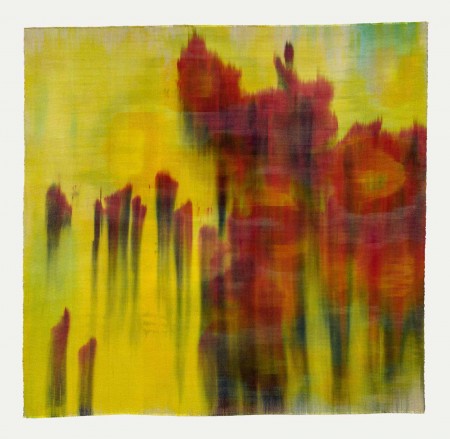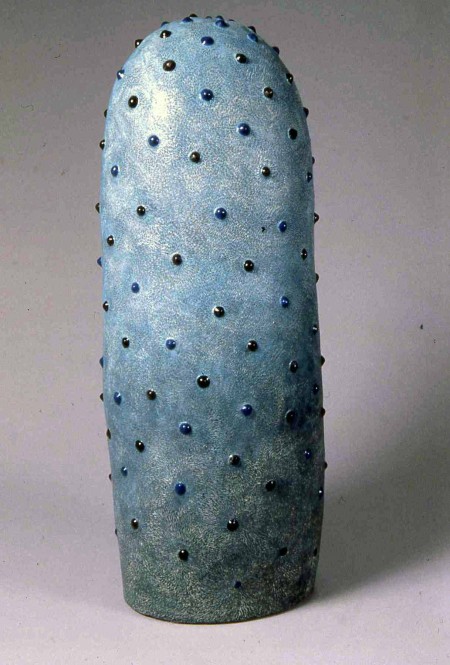

Color is the lush and unapologetic feature that binds the three artists whose solo presentations opened Friday, February 3rd, 2017 at the Carl Solway Gallery in Cincinnati and continue through April 29.

Hildur AsgeirsdóttirJónsson
Dynjandi, 2017
Silk, industrial dyes
120 x 113 inches
Hildur Ásgeirsdóttir Jónsson’s new woven silk weavings are the quiet scene-stealers of the Solway shows, though all three artists weigh in with thoughtful and inventive art work in three distinct mediums. The title of Jónsson’s presentation – Based on a Photograph – is a bit uninspired, and does not capture the imaginative approach she has taken with these new weavings. Jónsson takes a simple photograph of lichen from her native Iceland, where she still retains a home, and has distilled a new series of silk, painted weavings from this one photograph. It is her methodology that is key. The gallery explains: “The sources are often close-up images of lichen, but they also abstractly allude to larger swaths of land and sky. By painting with industrial dyes on the detached warp (vertical) threads of her works, attaching these dyed threads to a large-scale loom and weaving in the weft (horizontal) threads, she creates slightly off register, shimmering woven paintings that suggest expansive space rather than any literal sense of place.”
This process is particularly painstaking and marvelous. Imagine the artist having a photographic enlargement underneath the vertically aligned silk threads and she carefully paints the appropriate lines and shapes with her industrial dyes onto the vertical strands. Yes, it is painting. Yes, it is weaving. We dodge between the two worlds that are somewhat blurry as a result of the process and therein lay their pull. This is the marvel of it. Another artist who uses hand dying on fabric to great effect is Polly Apflebaum, who had a solo show at the Contemporary Arts Center a number of years ago, and both women share a bravura approach to color. It is the touch of the hand that makes the difference in both artists’ works.

Based on a Photo, Medium #5, 2016
Silk, industrial dyes
46 x 47 inches
Jónsson takes leaps of faith with color as she hones in on parts of the never-seen photograph that is her source. One painting, Based on a Photo, Medium #5, is all sunflower yellow and slight touches of acid-lime greens that are the background to carmine red flower-like forms that waterfall down the weaving into deep pthalo blue. It is as if a Monet’s field of poppies was reimagined using the tools of our twenty-first century – the camera and the computer. Though, there is nothing, absolutely nothing about these works that stiffly remind us of the Photoshopped mania of much of current art. Circling round again to her methodology, it is the intervention of the hand that is the master stroke. Jónsson has received numerous grants, commissions and awards including The Louis Comfort Tiffany Foundation 2015 Award and the 2015 group exhibition, Pretty Raw: After and Around Helen Frankenthaler at the Rose Art Museum at Brandeis University.

In the first and largest gallery of the Solway space, Catherine Richards’ new work, Capricious Alignment, showcases expansive textile photographic prints of hothouse flowers, especially orchids and flowers from exotic locals, combined with geometric swaths of colors. She told me that some of the colors are based on her research of colors used by World War II Fascist regimes – particular reds and blues of Italian Fascism. She explained that she is interested in exploring the colors associated with political power. It is a curious juxtaposition of controlled photographs of beautiful exotic flowers and color appropriated by Fascist regimes. The connection is not really clear, since the overall feel is of opulence and a most pleasing beauty. Perhaps that is the point that we are seduced before we know what is happening. But in these beautiful, highly pigmented wall works, pulsating with unadulterated colors, there is no whiff of politics.
The large-scale textile-photographic prints are paired beautifully with sleek, lean polychrome aluminum architectural elements. In her words, ”Order, decoration, and color create a dynamic psychology of space. The viewer’s perceptual experience is heightened by the sequential nature of both the tapestries and open grid structures. The juxtaposition of repeating floral environments alongside minimalist sculpture opens a dialogue between notions of order and chaos. Boundaries between exterior and interior are rendered fluid and playful.” Its overblown to call these tapestries in the strictest definition, yet they do have a hefty span and hang beautifully and freely as tapestries would.
What the minimalist, open-grid architectural elements do is activate the space. These architectural elements are stand-ins for angled walls as a contractor might rough in with 2 x 4s. Richards is a trained architect so this makes sense. Catherine slims down her architectural elements to be less than 1” in thickness so they stand delicately in place. The high sheen of the polychromed aluminum catches the reflections of the highly saturated colored textiles, the patterns of orchids and leaves reflected in the planes of the aluminum placed nearby. Each highly-saturated photo-printed textile is paired with its two-toned architectural counterpart. It’s too easy to say female and male pairing, as the read is more of highly-mediated, synthetic orchestration of compatible parts. It is wholly satisfying.
Richards embraces her personal training, in that she openly utilizes the language of architecture. A whole range of architects have made forays into the sexy art world, especially appearing at international art fairs and such like, designing art-cafes at the Venice Biennale and installation (rooms) at various international fairs. So, her piece Valance, in the large foyer of the Solway Gallery, speaks to the history of glass architecture. Lighted inside, the tall panes of glass create a freestanding, luminous column. Each pane is etched with plant patterns taken from her ancestral farm in Michigan. The sense here is of nature seen from the outside, in nature, as differentiated from the textiles inside the gallery that feature photos of exotic houseplants Richards takes. Overall her best sense of things is to blend her personal history in nature (Michigan) with her training and work as an architect.

Stoneware, coiled built, painted with colored slips,
sgraffito, clear glaze
53 H x 22 x 21.5 inches
Eva Kwong, a ceramic sculptor, as with the two other artists in this wonderful presentation, offers us highly polychromed art works. In her case, the art is hand-formed freestanding clay sculptures. Eva calls these recent works Love Between The Atoms. She references biological sources such as bacteria, diatoms and cells. The references are somewhat disappointingly generic and decorative. They are all beautifully crafted and Kwong is represented in collections in the U.S and Asia. They attract as a result of the fine craftsmanship and playfulness.
There are also beautifully crafted interpretations of the traditional vase form and of small, drum-like forms with flowers and other natural forms which further showcase Kwong’s sense of the playful. Two large clay sculptures bristle with texture and have a different feel, less decorative and playful, as if these forms suggest a more serious intention we are not privy to understand. They speak to Kwong’s complete command of her craft and a solo exhibition focusing on these more hulking, masculine forms might be very provocative.
The Solway Gallery is open Monday – Friday 9:00 – 5:00 pm and Saturday 12:00 – 5:00 pm, 424 Findlay Street, Cincinnati, Ohio.
–Cynthia Kukla